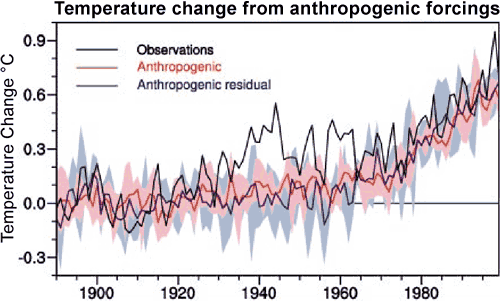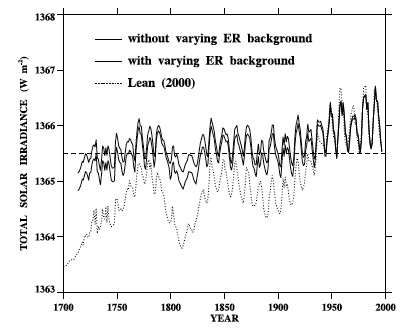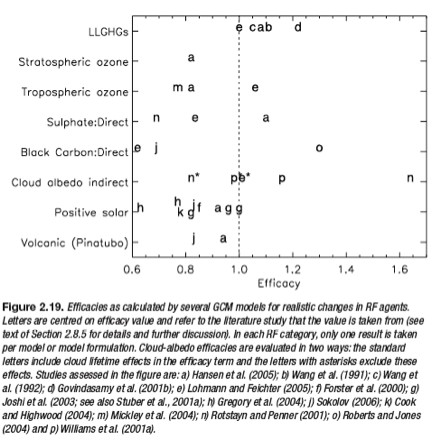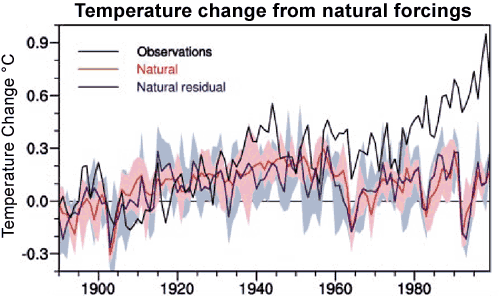What The Science Says:
While natural forcings can account for much of the early 20th Century warming, humans played a role as well. Additionally, the early century warming wasn't as large or rapid as the late century warming, to which these natural factors did not contribute in any significant amount.
But more importantly, we don't assume that the current warming is caused by humans because it's "unprecedented" or faster and larger than previous natural warming events. We know the current warming is anthropogenic because that's what the physical evidence tells us.Climate Myth: It warmed before 1940 when CO2 was low
"Of the rise in temperature during the 20th century, the bulk occurred from 1900 to 1940. It was followed by the aforementioned cooling trend from 1940 to around 1975. Yet the concentration of greenhouse gases was measurably higher in that later period than in the former. That drop in temperature came after what was described in the National Geographic as 'six decades of abnormal warmth'." (James Schlesinger)
Although there was a significant increase in global temperature in the early 20th Century, the rate of warming from 1910 to 1940 was lower than the rate of warming from 1975 to 2005, at about 1.3 vs. 1.8°C per century, respectively. That being said, it's worth taking a look at what caused the early century warming. Several different factors contributed.
Although humans were not burning very large amounts of fossil fuels or emitting large amounts of carbon dioxide (CO2) in the early 20th Century, relative to the late century, CO2 emissions were non-negligible and did play a role in the early century warming.
From 1900 to 1940, atmospheric CO2 levels increased from approximately 295 to 310 parts per million by volume (ppmv). The equilibrium temperature change caused by this increase in CO2 is the climate sensitivity (λ) multiplied by the radiative forcing, which is approximately 5.35 times the natural log of the change in CO2 (Myhre 1998):
The best estimate for the climate sensitivity parameter is 0.8 (Wm-2K-1). Thus at equilibrium, this CO2 change would be expected to cause a 0.22°C increase in the average global surface air temperature.
Meehl et al. (2004) plots the estimated anthropogenic contribution to temperature change in Figure 1 below. Most of the anthropogenic influence comes from CO2.

Figure 1: Climate model results from anthropogenic forcings compared to observations (black line). The red line is the average of the four-member ensemble. The pink shading is the model range. The blue line is the ensemble mean and the light blue shading is the ensemble range.
As you can see, the best estimate of the anthropogenic contribution to the 1910-1940 warming is approximately 0.1 to 0.15°C. This is smaller than the value we calculated above because the planet is not immediately in equilibrium. Much of the energy imbalance goes into the oceans, causing what's known as the "ocean lag" due to the thermal inertia of the oceans. The same lag effect applies to natural forcings.
The solar radiative forcing is the change in total solar irradiance (TSI) in Watts per square meter (Wm-2) divided by 4 to account for spherical geometry, and multiplied by 0.7 to account for planetary albedo (Meehl 2002). The albedo factor is due to the fact that the planet reflects approximately 30% of the incoming solar radiation. As with CO2, we calculate the equilibrium temperature change by multiplying the radiative forcing by the climate sensitivity parameter.
Wang, Lean, and Sheeley (2005) compared a flux transport model with geomagnetic activity and cosmogenic isotope records and to derive a reconstruction of TSI since 1713 (Figure 2).

Figure 2: Total Solar Irradiance from 1713 to 1996 (Wang 2005)
As you can see, in the early 20th Century, from about 1900 to 1940 there was an increase in TSI from about 1365.5 to 1366 Wm-2, which we can plug into the formula above. However, previous studies have estimated a TSI change as large as 2 Wm-2, so we'll estimate the change at 1 Wm-2. We then only need the solar climate sensitivity parameter.
The climate response to different radiative forcings is similar, but not identical. This is known as the "efficacy" of a radiative forcing. According to various studies of the direct solar forcing efficacy (from TSI alone), as summarized by the IPCC (Figure 3), it is likely smaller than the CO2 efficacy.

Figure 3: Efficacies of various radiative forcings as calculated in numerous different studies (IPCC 2007)
However, since there may be indirect solar effects not accounted for in the direct solar radiative forcing calculation, we'll conservatively estimate the solar climate sensitivity parameter as equal to the CO2 climate sensitivity of 0.8 (W m-2K-1). Thus at equilibrium, the solar change would be expected to cause a 0.15°C increase in the average global surface air temperature. Simlar to the anthropogenic contribution, the best estimate of the solar contribution to the 1910-1940 warming in Meehl (2004) is approximately 0.1 to 0.15°C (Figure 4).

Figure 4: Climate model results from the solar forcing compared to observations (black line).
CO2 and the Sun played the largest roles in the early century warming, but other factors played a part as well. For example, human aerosol emissions caused a slight cooling, ozone and other greenhouse gases caused a slight warming, low volcanic activity resulted in a slight warming, and natural cycles like the Atlantic Multidecadal Oscillation (AMO) may have contributed to the warming as well (Tett et al 2002). Meehl (2004) plots the net natural contribution to the warming in Figure 5.

Figure 5: Climate model results from all natural forcings compared to observations (black line).
The "skeptic" logic behind this argument is usually that if the early 20th Century warming was as large as the late century warming, and was natural, then the current warming could be natural as well (note that we've discussed the mid-century cooling elsewhere).
Ultimately while natural forcings can account for much of the early 20th Century warming, humans played a role as well. Additionally, the early century warming wasn't as large or rapid as the late century warming, to which these natural factors did not contribute in any significant amount.
But more importantly, we don't assume that the current warming is caused by humans because it's "unprecedented" or faster and larger than previous natural warming events. We know the current warming is anthropogenic because that's what the physical evidence tells us.
 |
The Skeptical Science website by Skeptical Science is licensed under a Creative Commons Attribution 3.0 Unported License. |